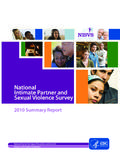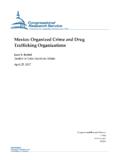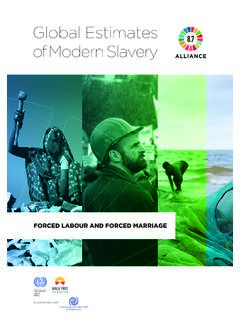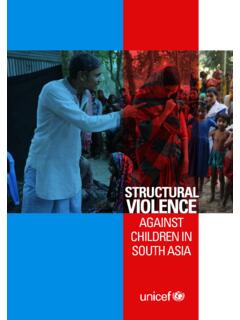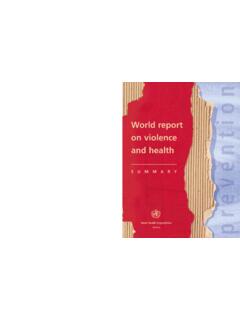Transcription of GLOBAL OVERVIEW: DRUG DEMAND DRUG SUPPLY
1 GLOBAL OVERVIEW: DRUG DEMAND DRUG SUPPLY United Nations, June 2021. All rights reserved worldwide. ISBN: 9789211483611 eISBN: 9789210058032 United Nations publication, Sales No. publication may be reproduced in whole or in part and in any form for educational or non-profit purposes without special permission from the copyright holder, provided acknowledgement of the source is made. The United Nations Office on Drugs and Crime (UNODC) would appreciate receiving a copy of any publication that uses this publication as a citation: World Drug Report 2021 (United Nations publication, Sales No. ).No use of this publication may be made for resale or any other commercial purpose whatsoever without prior permission in writing from UNODC. Applications for such permission, with a statement of purpose and intent of the reproduction, should be addressed to the Research and Trend Analysis Branch of content of this publication does not necessarily reflect the views or policies of UNODC or contributory organizations, nor does it imply any on the report are welcome and can be sent to:Division for Policy Analysis and Public Affairs United Nations Office on Drugs and Crime PO Box 500 1400 Vienna Austria Tel: (+43) 1 26060 0 Fax: (+43) 1 26060 5827E-mail: Website: cost lives.
2 In an age when the speed of information can often outstrip the speed of verification, the COVID-19 pandemic has taught us that it is crucial to cut through the noise and focus on facts, a lesson that we must heed in order to protect societies from the impact of use killed almost half a million people in 2019, while drug use disorders resulted in 18 million years of healthy life lost, mostly due to opioids. Serious and often lethal illnesses are more common among drug users, particularly those who inject drugs, many of whom are living with HIV and Hepatitis C. The illicit drug trade also continues to hold back economic and social development, while disproportionately impacting the most vulnerable and marginalized, and it constitutes a fundamental threat to security and stability in some parts of the the proven dangers, drug use persists and, in some contexts, proliferates. Over the past year, around 275 million people have used drugs, up by 22 per cent from 2010.
3 By 2030, demographic factors project the number of people using drugs to rise by 11 per cent around the world, and as much as 40 per cent in Africa is often a substantial disconnect between real risks and public perception. In some parts of the world for example, cannabis products have almost quadrupled in potency, and yet the percentage of adolescents who perceive cannabis as harmful has dropped by as much as 40 per cent, despite the evidence linking regular use to health problems, particularly in young people, and despite the correlation between potency and harm. New psychoactive substances also continue to be a challenge, as markets witness the introduction of new drugs that are unpredictable and poorly understood. Regulatory and legislative steps have been successful in stemming the tide globally, but in low-income countries the problem is on the rise; between 2015 and 2019, South and Central America recorded a fivefold rise in the amount of new synthetic psychoactive substances seized, while seizures in Africa increased from minor to substantial amounts.
4 Strong increases were also reported in South and Southwest Asia as well as the Near and Middle East. Meanwhile, the COVID-19 crisis has pushed more than 100 million people into extreme poverty, and has greatly exacerbated unemployment and inequalities, as the world lost 114 million jobs in 2020. In doing, so it has created conditions that leave more people susceptible to drug use and to engaging in illicit crop cultivation. Furthermore, disparities in access to essential controlled medicines around the world continue to deny relief to patients in severe pain. In 2019, four standard doses of controlled pain medication were available every day for every one million inhabitants in West and Central Africa, in comparison to 32,000 doses in North parallel, drug traffickers have quickly recovered from the initial setback caused by lockdown restrictions and are operating at pre-pandemic levels once again. Access to drugs has also become simpler than ever with online sales, and major drug markets on the dark web are now worth some $315 million annually.
5 Contactless drug transactions, such as through the mail, are also on the rise, a trend possibly accelerated by the facts about drugs and promoting science-based interventions is an absolute necessity if we are to reduce DEMAND and SUPPLY of drugs, while also facilitating access to controlled medicines for those in need. It is also the surest path to eliminating stigmatization and discrimination and providing adequate treatment, as seven in eight people who suffer from drug use disorders remain without appropriate the UN Office on Drugs and Crime we are dedicated to pursuing and promoting fact-driven, human rights-based approaches to drug control and treatment. I am proud to present to you this World Drug Report, which embodies our commitment to raising awareness and combating is my hope that this report will inform policymakers, practitioners, and the general public on the facts of the world drug problem, and provide them with a powerful tool to share evidence and information, and in doing so help save and preserve Waly, Executive Director United Nations Office on Drugs and CrimePREFACEGLOBAL OVERVIEW | Preface32 WORLD DRUG REPORT 2021 EXECUTIVE SUMMARYPOLICY IMPLICATIONSCOVID-19 AND DRUGS: IMPACT AND OUTLOOKDRUG MARKET TRENDS: COCAINE, AMPHETAMINE-TYPE STIMULANTSDRUG MARKET TRENDS.
6 CANNABIS, OPIOIDSGLOBAL OVERVIEW OF DRUG DEMAND AND DRUG SUPPLYBOOKLETBOOKLETBOOKLETBOOKLETBOOKLE TCONTENTSPREFACE 3 EXPLANATORY NOTES 7 SCOPE OF THE BOOKLET 9 DRUG DEMAND 11 Looking towards 2030: how will demographic changes impact drug use? 11 Impact of drug use on the health of the user and on public health 19 Extent of drug use 19 Health consequences of drug use 32 DRUG SUPPLY 51 Drug production and trafficking 51 Drug trafficking over the Internet 65 Drug trafficking over the clear web.
7 The example of substances supplying synthetic drugs markets 66 Drug trafficking over the dark web 75 ANNEX 91 GLOSSARY 105 REGIONAL GROUPINGS 107 GLOBAL OVERVIEW | Contents25 AcknowledgementsThe World Drug Report 2021 was prepared by the Research and Trend Analysis Branch, Division for Policy Analysis and Public Affairs, United Nations Office on Drugs and Crime (UNODC), under the supervision of Jean-Luc Lemahieu, Director of the Division, and Angela Me, Chief of the Research and Trend Analysis Branch, and the coordination of Chlo Carpentier, Chief of the Drug Research overview Chlo Carpentier Angela Me Analysis and drafting Nicole CookPhilip DavisMichael LohmullerKamran NiazThomas PietschmannBarbara Remberg (INCB Secretariat)Data management and estimate productionMonika Barratt (RMIT University)Enrico BisognoDiana CameriniConor CreanHernan EpsteinNatalia IvanovaSabrina LevissianosVirginia Macdonald (WHO)Bradley Mathers (WHO)Andrea Oterov Martin RaithelhuberUmidjon RakhmonberdievFrancesca RosaAli SaadeddinKeith Sabin (UNAIDS)
8 Tun Nay SoeEditing Jonathan GibbonsGraphic design and production Anja Korenblik Suzanne Kunnen Kristina Kuttnig Maria Moser Lorenz PerszykAdministrative support Andrada-Maria Filip Iulia LazarReview and commentsThe World Drug Report 2021 benefited from the expertise of and invaluable contributions from UNODC colleagues in all divisions and from the INCB Secretariat. The Research and Trend Analysis Branch acknowledges the invaluable contributions and advice provided by the World Drug Report Scientific Advisory Committee:Jonathan CaulkinsPaul GriffithsMarya HynesVicknasingam B. KasinatherCharles ParryAfarin Rahimi-MovagharPeter ReuterAlison RitterFrancisco ThoumiThe analysis on the GLOBAL situation on hepatitis C in Booklet 2 benefited from a contribution from the Department of GLOBAL HIV, Hepatitis and Sexually Transmitted Infections Programmes of analysis on purchases of drugs on the dark web in Booklet 2 is based on original data graciously shared by the GLOBAL Drug survey WORLD DRUG REPORT 2021 EXPLANATORY NOTESThe designations employed and the presentation of the material in the World Drug Report do not imply the expression of any opinion whatsoever on the part of the Secretariat of the United Nations concerning the legal status of any country, territory, city or area, or of its authorities.
9 Or concerning the delimitation of its frontiers or and areas are referred to by the names that were in official use at the time the relevant data were there is some scientific and legal ambiguity about the distinctions between drug use , drug misuse and drug abuse , the neutral term drug use is used in the World Drug Report. The term misuse is used only to denote the non-medical use of prescription uses of the word drug and the term drug use in the World Drug Report refer to substances controlled under the international drug control conventions, and their non-medical analysis contained in the World Drug Report is based on the official data submitted by Member States to the UNODC through the annual report questionnaire unless indicated data on population used in the World Drug Report are taken from: World Population Prospects: The 2019 Revision (United Nations, Department of Economic and Social Affairs, Population Division). References to dollars ($) are to United States dollars, unless otherwise to tons are to metric tons, unless otherwise stated.
10 The following abbreviations have been used in the present booklet: ASEANA ssociation of Southeast Asian NationsATS amphetamine-type stimulantsCBD cannabidiolCOVID-19coronavirus diseaseDALYs disability-adjusted life yearsDMTdimethyltryptamine -9-THC delta-9-tetrahydrocannabinolEMCDDAE uropean Monitoring Centre for Drugs and Drug AddictionEuropol European Union Agency for Law Enforcement CooperationGBLgamma-butyrolactoneGHBgamm a-hydroxybutyric acidINCBI nternational Narcotics Control BoardLSDlysergic acid diethylamideMDMA3,4-methylenedioxymetamp hetamineMPDV3,4-methylenedioxypyrovalero neNPS new psychoactive substancesPWID people who inject drugsRMIT Royal Melbourne Institute of TechnologyS-DDDdefined daily doses for statistical purposesUNAIDSJ oint United Nations Programme on HIV/AIDSUNDPU nited Nations Development ProgrammeUNODCU nited Nations Office on Drugs and CrimeWHOW orld Health OrganizationGLOBAL OVERVIEW | Explanatory notes27 SCOPE OF THE BOOKLET Constituting the second part of the World Drug Report 2021.










